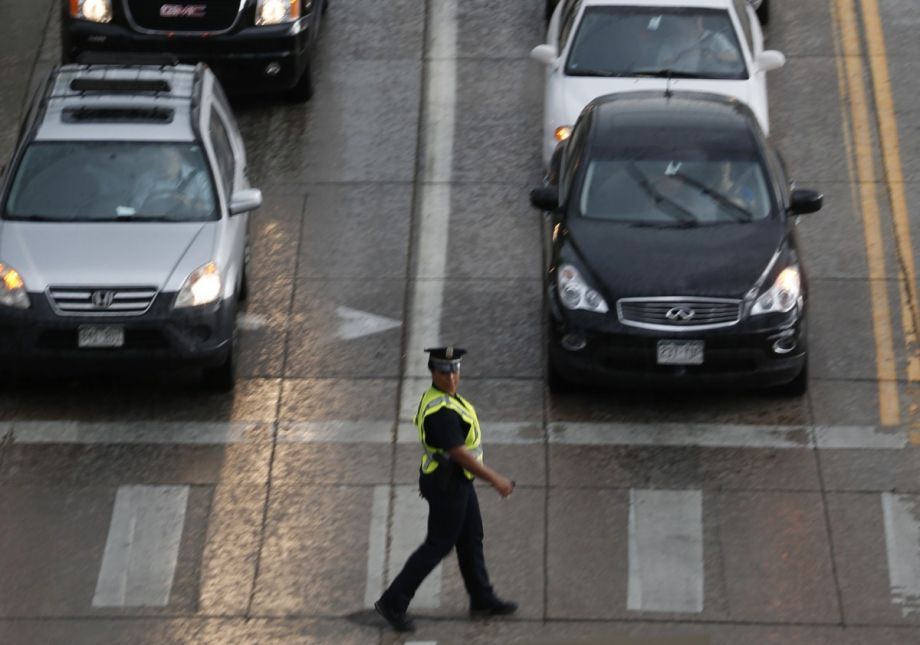For the first time in five years, there are more downtown Denver commuters driving alone to work than taking transit. The finding comes from the Downtown Denver Partnership’s annual Downtown Denver Commuter Survey and marks a hitch in the Partnership’s goal of reducing solo drive commutes to 35 percent by 2021.
“We were naturally a little disappointed to see the transit use rates go down. We weren’t entirely surprised because we’ve seen that trend over the last couple years, but it was disappointing to see drive alone rates go up,” says Aylene McCallum, the Partnership’s director of downtown environment.
According to the survey, solo driving is up to 40.3 percent after holding steady around 38.5 percent since 2012. As McCallum notes, transit use by downtown commuters has been trending downward for the last several years — from 44.6 percent in 2013 to its current 39.6 percent. Biking and walking currently account for 6.6 and 5.2 percent of the mode share respectively.
There are a number of contributing factors, but both McCallum and Transit Alliance Executive Director Kathleen Osher agree that the primary culprit is Denver’s booming population growth.
“The city is adding so many people on an almost daily basis. When people are new to the city they do what’s intuitive. We’re looking at the next evolution of how transit becomes that intuitive choice,” says Osher.
From 2014 to 2015, Denver was the ninth fastest-growing large city in the country, according the Census Bureau. In a year, the city added 18,572 people, bringing the population up to 682,545.
McCallum points to low gas prices and the fact that driving is still faster than transit in some situations as other factors in new people choosing to drive. “There haven’t been a lot of sticks to encourage people to try other modes,” she says.
Some of the highest transit use comes from commuters who live farthest out in the suburbs northwest and southwest of the city. Unsurprisingly, those suburbs have good access to rail lines that run into the city.
Inner-ring suburban commuters are using transit the least. “Folks who don’t use it are within 5 miles of downtown Denver. Only 25 percent are using transit and 30 percent are driving alone,” McCallum explains. “Part of the problem is transit in that radius of downtown Denver just isn’t super competitive. There are lots of stops. A 10-minute commute can turn into a 20-minute commute. That’s not a huge difference, but people think, ‘my commute is doubling.’”
Though transit use is trending in the wrong direction for the city, now is arguably a good time to find out about it. The city is in the earliest stages of crafting a new transit master plan called Denver Moves: Transit. McCallum and Osher are both members of the Denver Moves task force.
Osher wants to see transit get more competitive with driving by increasing frequency. She says the city currently defines “frequent service” as buses arriving in 15-minute intervals. “It’s not [frequent enough]. You still need a schedule to accommodate that,” she says. “But if buses come more frequently, things like reliability aren’t as big a concern.”
As such, Osher’s pushing for creating high-frequency transit corridors as part of the Denver Moves plan. She also wants the city to put more consideration into the pedestrian environment around transit stops. “I think one of the most important indicators [for whether or not people will use transit] is the environment in which you have to wait for a bus and if there are logical pedestrian connections to and from transit.” (As Next City covered in 2016, when it comes to walking to and from stops, sidewalk maintenance has been a problem in Denver.)
The Downtown Partnership says employer-subsidized transit passes along with reducing employer-subsidized parking are key to getting people out of their cars and onto bus and rail. The survey shows that 68 percent of employees receive a subsidized transit pass and 37 percent receive a subsidized parking space. That pass can be a strong motivator: Of respondents, 67 percent said subsidized transit passes make them more likely to use transit and 28 percent said it would make them less likely to drive alone. But nothing was likelier to make someone drive than free parking: 88 percent of commuters said employer-subsidized parking makes them more likely to drive alone, and 44 percent said subsidized parking would make them less likely to use transit.
In addition to the transit master plan, the city of Denver is working on master plans for land use and transportation, trails, and parks. Osher is confident that big picture planning will allow them to turn around the downward trend for transit.
“Our transportation choices feel a little limited right now,” she says. “But that master planning overlap can allow us to capitalize on greatest opportunities for transit.”

Josh Cohen is Crosscut’s city reporter covering Seattle government, politics and the issues that shape life in the city.
Follow Josh .(JavaScript must be enabled to view this email address)



_600_350_80_s_c1.jpg)




_on_a_Sunday_600_350_80_s_c1.jpeg)







